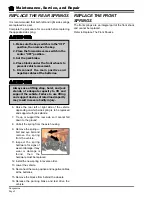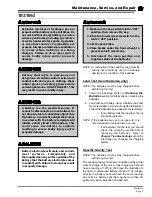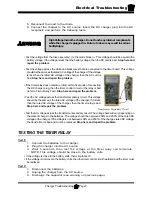
Maintenance, Service, and Repair
Batteries
Page 6
Explosive mixtures of Hydrogen gas are
present within battery cells at all times. Do
not work with or charge battery in an area
where open flames (including gas furnace
or water heater pilots), sparks, cigarettes,
or any other sources of combustion are
present. Always provide ample ventilation
in rooms where batteries are being
charged. Failure to do so may result in
severe bodily injury and/or property
damage.
Battery electrolyte will stain and corrode
most surfaces. Immediately and
thoroughly clean any surface outside of the
battery that the battery electrolyte comes
in contact with. Failure to clean may result
in property damage.
1. Make sure the key-switch is in the “OFF”
position, then remove the key.
2. Place the forward-reverse switch in the
center “OFF” position.
3. Set the park brake.
4. Place blocks under the front wheels to
prevent vehicle movement.
5. Disconnect the main positive and
negative cables at the batteries.
REPLACING (6-VOLT BATTERIES ONLY)
NOTE: If the batteries are over one year old, it is
recommended to replace them as a set.
6. Thoroughly clean the batteries and battery
compartment. Refer to
Cleaning
in this section
for information regarding cleaning the batteries.
7. Remove the battery hold downs.
8. Inspect the battery hold downs for corrosion. If
any signs of corrosion are seen then the battery
hold downs should be replaced.
9. Remove all battery jumpers from both posts of
the battery or batteries being replaced.
NOTE: It is recommended to replace the battery
jumpers when replacing the batteries.
10. Remove the batteries from the vehicle.
11. Inspect the battery compartment for signs of
corrosion.
12. If minimal signs of corrosion are seen, then the
damaged paint should be stripped off and the entire
battery compartment prepped and repainted.
13. If there are excessive signs of corrosion, then it
may be necessary to replace some of the frame
members or completely rebuild the battery
compartment.
14. Inspect the main positive and negative cables and
terminals, charger cables and terminals and 12-
volt tap wiring. If any of the terminals or wires show
signs of corrosion, then they must be repaired or
replaced.
Do not leave cables on batteries that have
been removed from the vehicle. Cables left
on batteries could cause a short circuit
resulting in battery explosion, severe
bodily injury and/or property damage.
A battery is a live electrical source. It
cannot be disconnected or neutralized. Do
not drop any tool or conductive object onto
the battery. A conductive object that comes
in contact with the battery terminals will
initiate a short circuit of the battery. This
could cause the battery to explode
resulting in severe bodily injury and/or
property damage.
Battery electrolyte is poisonous and
dangerous. It contains sulfuric acid. Avoid
contact with skin eyes or clothing. Wear
rubber gloves and safety glasses while
servicing batteries. DO NOT INGEST! This
may result in severe bodily injury.
Summary of Contents for MB-238-00
Page 2: ......
Page 6: ...TAYLOR DUNN...
Page 28: ...TAYLOR DUNN...
Page 44: ...Maintenance Service and Repair Steering Page 8 Exploded View of Steering Gear...
Page 64: ...TAYLOR DUNN...
Page 112: ...TAYLOR DUNN...
Page 149: ...TABLE OF CONTENTS Wire Diagrams Complete Vehicle 2...
Page 158: ...Illustrated Parts Parts Page 8 Transmission Gear Case...
Page 162: ...Illustrated Parts Parts Page 12 Rear Brakes Brake Body Assembly...
Page 166: ...Illustrated Parts Parts Page 16 Brake Lines Illustration not available...
Page 168: ...Illustrated Parts Parts Page 18 Motor...
Page 170: ...Illustrated Parts Parts Page 20 Wheels and Tires Ref wheel hub 1 2 3 Rear Suspension...
Page 172: ...Illustrated Parts Parts Page 22 Speed Control Panel Instrument Panel dash...
Page 182: ...Illustrated Parts Parts Page 32 Seat Cushions Deck and Lights Frame Illustration not available...
Page 184: ...Illustrated Parts Parts Page 34 Decals...
















































